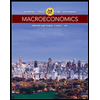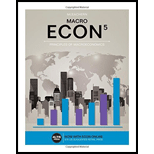
Subpart (a):
Effect of transactions.
Subpart (a):
Explanation of Solution
The effect of the transactions a, b, c on the consolidated
Column (a) also answers the transaction (d): Commercial banks increase their reserves after the Fed increases the interest rate and pays reserves.
|
Consolidated Balance Sheet: All Commercial Banks (in $ billions) | ||||
| (a) | (b) | (c) | ||
| Assets: | ||||
| Reserves | $30 | 32 | 31 | 30 |
| Securities | 60 | 58 | 60 | 60 |
| Loans | 60 | 60 | 60 | 60 |
| Liabilities and Net Worth: | ||||
| Checkable deposits | $150 | 150 | 150 | 150 |
| Loans from Federal Reserve Banks | 3 | 3 | 4 | 3 |
|
Consolidated Balance Sheet: 12 Federal Reserve Banks (in $ billions) | ||||
| (a) | (b) | (c) | ||
| Assets: | ||||
| Securities | $60 | 62 | 60 | 60 |
| Loans to Commercial Banks | 3 | 3 | 4 | 3 |
| Liabilities and Net Worth: | ||||
| Reserves of Commercial Banks | $30 | 32 | 31 | 30 |
| Treasury deposits | 3 | 3 | 3 | 3 |
| Federal Reserve Notes | $27 | 27 | 27 | 27 |
Assume the reserve ratio is 20%.
Suppose Fed purchases $2 billion worth of securities. This would increase commercial bank reserves by $2 billion (from $30 billion to $32 billion) and reduce securities by $2 billion (from $60 billion to $ 58 billion). This responds to the direct and immediate effect to the consolidated balance sheet.
With checkable deposits of $150 billion,
Concept Introduction:
Reserve Ratio: it is the ratio or percentage of deposit that banks must hold in liquid form.
Money Supply: It is the total money in circulation in the economy. It involves currency notes, deposits and other forms of liquid asset.
Money Multiplier: It is the ratio of reserves to the total amount of reserves in the banking system. It is the amount that bank generates or creates with each unit of reserves.
Open Market Operation (OMO): It is the monetary control mechanism employed which involves buying and selling of government securities in the open market to routine (expand or contract) the amount of money in the banking system.
Subpart (b):
Effect of transactions.
Subpart (b):
Explanation of Solution
Suppose the commercial banks borrow $1 billion from the Fed at the discount rate. This would increase commercial bank reserves by $1 billion (from $30 billion to $31 billion) in the asset side of the commercial bank and also would increase loans from Fed to $4billion (from $3 billion) in the liabilities side. This responds to the direct and immediate effect to the consolidated balance sheet.
Now, the excess reserve is $1 billion
Concept Introduction:
Reserve Ratio: it is the ratio or percentage of deposit that banks must hold in liquid form.
Money Supply: It is the total money in circulation in the economy. It involves currency notes, deposits and other forms of liquid asset.
Money Multiplier: It is the ratio of reserves to the total amount of reserves in the banking system. It is the amount that bank generates or creates with each unit of reserves.
Open Market Operation (OMO): It is the monetary control mechanism employed which involves buying and selling of government securities in the open market to routine (expand or contract) the amount of money in the banking system.
Subpart(c):
Effect of transactions.
Subpart(c):
Explanation of Solution
There is no immediate effect on the consolidated balance sheet due to the change in the reserve ratio. But in the longer term, when the reserve ratio decreases from 20% to say, 18%; the
Concept Introduction:
Reserve Ratio: it is the ratio or percentage of deposit that banks must hold in liquid form.
Money Supply: It is the total money in circulation in the economy. It involves currency notes, deposits and other forms of liquid asset.
Money Multiplier: It is the ratio of reserves to the total amount of reserves in the banking system. It is the amount that bank generates or creates with each unit of reserves.
Open Market Operation (OMO): It is the monetary control mechanism employed which involves buying and selling of government securities in the open market to routine (expand or contract) the amount of money in the banking system.
Subpart (d):
Effect of transactions.
Subpart (d):
Explanation of Solution
Commercial banks increase their reserves after the Fed increases the interest rate that it pays on reserves can be depicted by Columns A it shows that the increase in reserves came from selling securities. Column B also shows increase in reserves but it came from loans from the Federal Reserve Banks and it is unlikely that Fed would lend at an interest rate lower than it pays commercial banks for the reserve. When the Fed increases the interest rate it pays on reserve, the commercial bank increases reserves by decreasing loan to its customers.
Concept Introduction:
Reserve Ratio: it is the ratio or percentage of deposit that banks must hold in liquid form.
Money Supply: It is the total money in circulation in the economy. It involves currency notes, deposits and other forms of liquid asset.
Money Multiplier: It is the ratio of reserves to the total amount of reserves in the banking system. It is the amount that bank generates or creates with each unit of reserves.
Open Market Operation (OMO): It is the monetary control mechanism employed which involves buying and selling of government securities in the open market to routine (expand or contract) the amount of money in the banking system.
Want to see more full solutions like this?
Chapter 36 Solutions
ECO 2020 INCLUSIVE ACCESS
- Critically analyse the five (5) characteristics of Ubuntu and provide examples of how they apply to the National Health Insurance (NHI) in South Africa.arrow_forwardCritically analyse the five (5) characteristics of Ubuntu and provide examples of how they apply to the National Health Insurance (NHI) in South Africa.arrow_forwardOutline the nine (9) consumer rights as specified in the Consumer Rights Act in South Africa.arrow_forward
- In what ways could you show the attractiveness of Philippines in the form of videos/campaigns to foreign investors? Cite 10 examples.arrow_forwardExplain the following terms and provide an example for each term: • Corruption • Fraud • Briberyarrow_forwardIn what ways could you show the attractiveness of a country in the form of videos/campaigns?arrow_forward
 Macroeconomics: Private and Public Choice (MindTa...EconomicsISBN:9781305506756Author:James D. Gwartney, Richard L. Stroup, Russell S. Sobel, David A. MacphersonPublisher:Cengage Learning
Macroeconomics: Private and Public Choice (MindTa...EconomicsISBN:9781305506756Author:James D. Gwartney, Richard L. Stroup, Russell S. Sobel, David A. MacphersonPublisher:Cengage Learning Economics: Private and Public Choice (MindTap Cou...EconomicsISBN:9781305506725Author:James D. Gwartney, Richard L. Stroup, Russell S. Sobel, David A. MacphersonPublisher:Cengage Learning
Economics: Private and Public Choice (MindTap Cou...EconomicsISBN:9781305506725Author:James D. Gwartney, Richard L. Stroup, Russell S. Sobel, David A. MacphersonPublisher:Cengage Learning
 Essentials of Economics (MindTap Course List)EconomicsISBN:9781337091992Author:N. Gregory MankiwPublisher:Cengage Learning
Essentials of Economics (MindTap Course List)EconomicsISBN:9781337091992Author:N. Gregory MankiwPublisher:Cengage Learning Brief Principles of Macroeconomics (MindTap Cours...EconomicsISBN:9781337091985Author:N. Gregory MankiwPublisher:Cengage Learning
Brief Principles of Macroeconomics (MindTap Cours...EconomicsISBN:9781337091985Author:N. Gregory MankiwPublisher:Cengage Learning Principles of Economics (MindTap Course List)EconomicsISBN:9781305585126Author:N. Gregory MankiwPublisher:Cengage Learning
Principles of Economics (MindTap Course List)EconomicsISBN:9781305585126Author:N. Gregory MankiwPublisher:Cengage Learning





